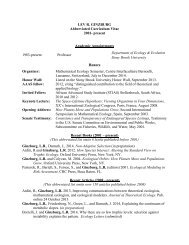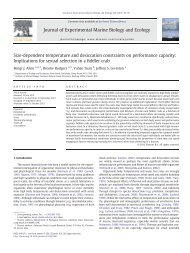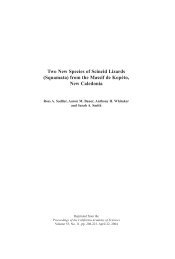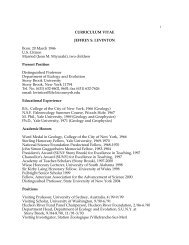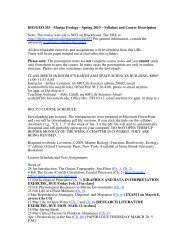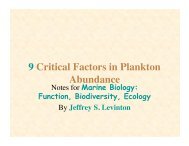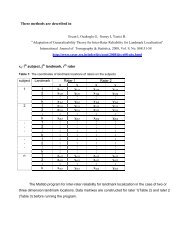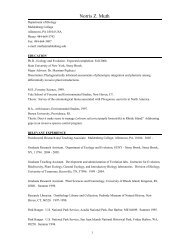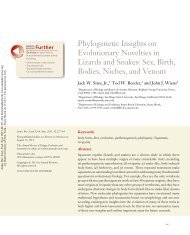Curriculum Vitae John J. Wiens - Stony Brook University
Curriculum Vitae John J. Wiens - Stony Brook University
Curriculum Vitae John J. Wiens - Stony Brook University
Create successful ePaper yourself
Turn your PDF publications into a flip-book with our unique Google optimized e-Paper software.
<strong>Wiens</strong>-C.V. page 23 of 24<br />
(115) <strong>Wiens</strong>, J. J. 2011. The niche, biogeography, and species interactions.<br />
Philosophical Transactions of the Royal Society of London, Series B 366:2336–<br />
2350.<br />
***Invited paper for symposium on "Ecology and Biogeography"<br />
(116) <strong>Wiens</strong>, J. J., M. Sparreboom, and J. W. Arntzen. 2011. Crest evolution in<br />
newts: implications for reconstruction methods, sexual selection,<br />
phenotypic plasticity, and the origin of novelties. Journal of Evolutionary<br />
Biology 24:2073–2086.<br />
***Cover article.<br />
(117) Townsend, T., D. G. Mulcahy, J. W. Sites Jr., C. A. Kuczynski, J. J. <strong>Wiens</strong>,<br />
and T. W. Reeder. 2011. Phylogeny of iguanian lizards inferred from 29<br />
nuclear loci, and a comparison of concatenated and species-tree<br />
approaches for an ancient, rapid radiation. Molecular Phylogenetics and<br />
Evolution 61:363–380.<br />
(118) Pyron, R. A., and J. J. <strong>Wiens</strong>. 2011. A large-scale phylogeny of Amphibia<br />
including over 2,800 species, and a revised classification of extant frogs,<br />
salamanders, and caecilians. Molecular Phylogenetics and Evolution<br />
61:543–583.<br />
(119) Fisher-Reid, M. C., and J. J. <strong>Wiens</strong>. 2011. What are the consequences of<br />
combining nuclear and mitochondrial data for phylogenetic analysis?<br />
Lessons from Plethodon salamanders and 13 other vertebrate clades.<br />
BMC Evolutionary Biology 11:300<br />
***Highly accessed<br />
(120) Sites, J. W., Jr., T. W. Reeder, and J. J. <strong>Wiens</strong>. 2011. Phylogenetic insights<br />
on evolutionary novelties in lizards and snakes: sex, birth, bodies,<br />
niches, and venom. Annual Review of Ecology, Evolution and Systematics<br />
42:227–244.<br />
**Invited review<br />
(121) Carrete-Vega, G., and J. J. <strong>Wiens</strong>. 2012. Why are there so few fish in the<br />
sea? Proceedings of the Royal Society of London (published on line 8 Feb.)<br />
***Featured as “Research Highlight” in Nature, 16 Feb. 2012<br />
***Featured on many news web sites including CBS News, msnbc.com, EarthSky,<br />
LiveScience, NewScientist, DailyMail, Huffington Post, World News Australia,<br />
TheNewsWorld, WebIndia123, TopNews (India), SkyNews (Australia),<br />
NewsTrackIndia, LeFigaro (France), Spiegel Online (Germany), News Pano,<br />
PhysOrg.com, WorldNews.com, Yahoo News, Dallas Morning News, Australian<br />
Geographic, United Press International, Press Association, OnePakistan,<br />
IndiaVision, Zanost.com (Croatia), Dalje.com (Croatia), JornalCiencia (Brazil),<br />
ExpressoAmbiental (Brazil), TechMoney (Poland), Polska Agencja Prasowa<br />
(Poland), Technologijos (Lithuania), aePiot (Romania), Seasons (France), Stop<br />
(Hungary), Nu (Netherlands), News Center (China), China Daily (China),<br />
Mysterious Earth (China), and others for a total of 17 countries (U.S., U.K.,



